Introduction
The media has become one of the most used tools of influence in many democratic processes to inspire the public and dictate the behavior of candidates and voters.
Studies indicate that the media has been a reliable source of information that has provided citizens with information they require in order to make independent and well informed decisions especially on matters of political democracy and choice of leadership.
However Kramer points out that in the 2008 general election campaigns for presidential and primary nominations positions in the United States of America proved that the media today has shifted from being mere custodian of facts they were once known to be, to purveyors of misinformation and unbalanced media coverage (208).
As this paper examines, the media did not just heighten campaign knowledge among the American public. It also played a major role in influencing the outcome of the United States general elections in 2008. It is on this front that this paper intrinsically evaluates the United States 2008 election campaigns, analyses the candidates’ use of media during the campaign processes and the role of media in influencing election results.
The media and the US presidential candidates in 2008
Bignon and Miscio indicate that the 2008 presidential general elections saw significant criticisms leveled against the media for their predisposition in presidential and primary candidates’ coverage (385). An example of criticism was that which was leveled against the NBC News by Tim Russert in which the questions that Obama and Hilary were asked were disproportionate in the sense that Hilary, the then democratic presidential contender received very tough questions while Obama’s questions were simpler.
Some of the harassing questions during that news interview included those asking Hilary to provide the name of the newly elected Russian president, and whether she supported the move to have illegal immigrants given driver’s license. As a matter of fact, this was seemingly an open bias against the female candidate. Worse still, it may have portrayed a negative image of Hillary as a leader who is not sharp enough in terms of the on-going global politics.
Reports from Pew Research Centre in US provide an in-depth profile on the role of media influence and indicate that during the 2008 presidential campaigns, many journalists and media outlets were bent on seeing that Barrack Obama won the election (Robbins 52).
Certain opinion polls also indicate that Obama had a strong support of about 70% registered voters compared to John McCain’s 9% (Dubriwny 507). Similar reports analyzing media influence pilloried on the role of media in 2008, and posit that media coverage in terms of news was unfair since its coverage for McCain was 30% while that for Obama was 67% (Dubriwny 507).
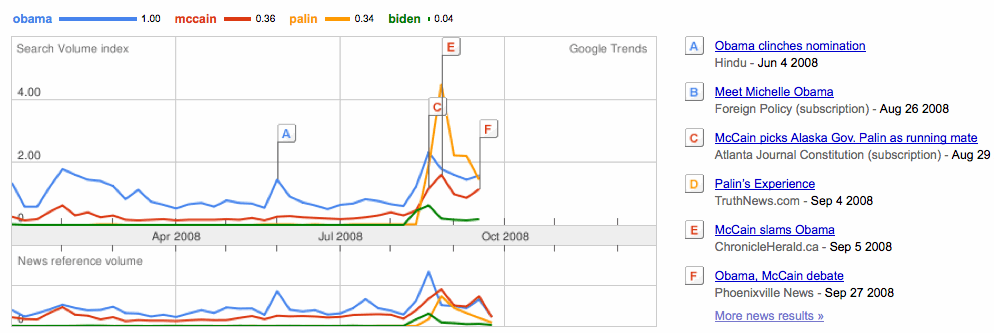
Media Coverage of female candidates
Evidences of sexism and gender bias in media coverage of the 2008 presidential media coverage
The 2008 general elections in the US was marked by massive sexism and gender bias for female contestants at both primary and presidential levels. Of major importance were Sarah Palin and Hilary Clinton who were massively impacted on by apparent double standards measures in media coverage.
Most of the statements and questions they raised and which deserved coverage did not receive equal coverage as that of their fellow male candidates. Bignon and Miscio note that this immensely reflected the perception that the media and a section of individuals in the society had on the female gender (387). Indeed, had the media been fair and balanced in their coverage of both male and female gender campaigns, the female candidates would have garnered substantial votes.
Sexism and gender discrimination in Sarah Palin and Hillary Clinton’s campaigns
In his publication, Kramer points out that gender discrimination and sexism on Sarah Palin and Hillary Clinton’s campaigns by the media began taking effect especially for Palin when announcements came that she would be the vice president to John McCain, and would be running on a presidential ticket as the first republican female (208).
What followed her selection as a running mate were brand naming reports from media outlets calling her ‘former beauty queen’ seeking candidacy (Robbins 53). Well, while one might not feel the impact of the labels given to her, the truth of the matter was that Palin was just more than a beauty queen. She was and still is a competent woman who had rights to compete fairly with other candidates and who possessed unique leadership skills.
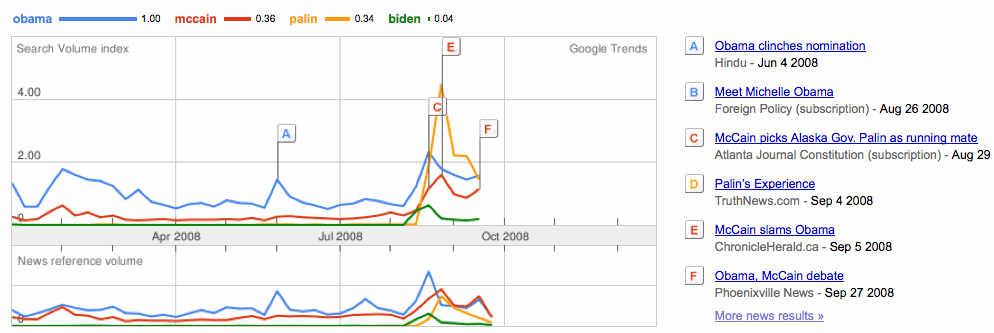
Certain critiques of conventions indicate that the media represented Hilary Clinton as a woman who did not carry some weight in politics citing that she was going for leadership position to represent herself. In disagreement with the position the media took, it is imperative to point out that by discriminating against these women, the media undermined the important ideals of feminism and sent forth resilient and piquant messages through their actions that women could not take part in male dominated politics.
Denying women candidates equal media coverage was moronic and equaled to telling all women in the US that they do not deserve to vote. Analysts indicate that media sexism was heightened against both Hilary and Palin’s 2008 campaign through media double standards in coverage (Robbins 50). They were given little time for debates and most issues that they raised were not adequately reported as compared to those of their opponents.
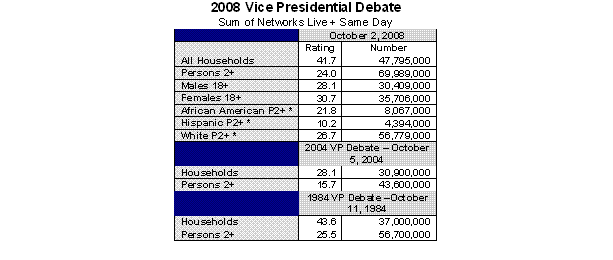
Besides, Ross explains that McCain strategy sought to reach out to women by selecting Sarah Palin as his running mate (180). This strategy was deemed to fill the gap left by the democrats’ choice of the seemingly ‘unpopular’ Obama as opposed to Hilary Clinton who was the expectations of many. However, Palin became a center of attacks by major celebrities, media and even youths who were fast becoming polarized towards Obama wave.
Media used to present candidates to voters
Television use
Babad and Peer refer to TV as the best interface that was used in the 2008 general elections as it linked the public with their candidates (57). Besides, candidates used the television to present their views and ideas to the public. It equally gave them the necessary high profile analysis of their agendas and progress as the voting day drew nearer. It is this popularity that that saw the use of media such as newspapers decline as a persuasive tool.
However, unlike other previous campaigns, the 2008 campaigns saw great media bias in television coverage of candidates, and which influenced voters to vote for particular candidates. Even though presidential candidates massively used TV media to carry out their campaigns and debate on issues, their coverage was disproportionate and cases of sexism and discrimination against women candidates were rampant.

Use of newspapers
Ross argues that though newspapers use as a medium for presenting the candidates has declined over time, it remained a key source of gathering conclusive analysis of the 2008 candidates and their diverse policies (180). It played an effective role especially for the older conservative generations as opposed to the youths who were more to the television and internet.
However, there were allegations that newspapers published reports that potentially biased and which to certain degrees influenced voters to vote for candidates (Robbins 54). Of importance were endorsements from right leaning newspapers for republican candidates and left-leaning newspapers for democratic candidates.
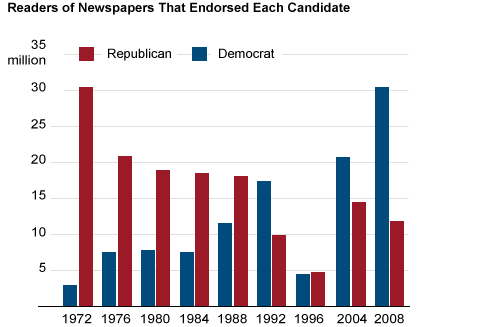
Bignon and Miscio point out that in the American history, newspaper endorsement for presidential and primary candidates has been commonplace for more than a century and has greatly influenced election outcomes (389). Until 2008, overwhelming support and endorsements from newspaper editorial pages favored almost all republican presidenltial candidates with a few balancing out to reach out for that democrats candidates.
Reports indicate that republicans enjoyed newspaper endorsements of up to 84% from 1972-88 with extreem instances being 90% when Richard Nixon won against Senator George McGovern (Dubriwny 507). Bill Clointon also received editorial nods in 1992 as a democrat. In 2008, editirorial support for Obama was higher than that for the republicans and played a major role in influencing the outcomes.
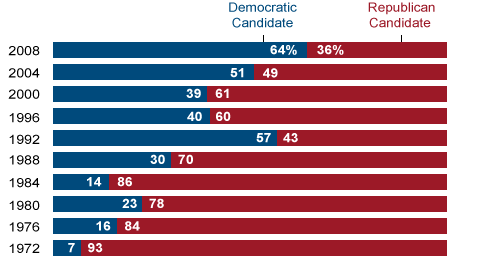
Though the Obama’s landslide win of the 2008 election has been interpreted differently by analysts, there is seen to be concurrence in certain aspects. One such facet as Kramer credits is the high level of energized media involvement that was used to reach more people in all states (208).
In concurrence with Kramer’s argument, Babad and Peer explain that Obama managed to maintain a solid touch with youths who form the majority in the nation through modern technology and great media coverage co pared to that of the opposing candidate (57). Besides, he increased his spending on television adverts and raising personnel to link millions through phone messaging, social networking and blogging.
Conclusions
It is from the above discussion that this paper concludes by supporting the thesis statement, ‘The media has become one of the most used tools of influence in many democratic processes to inspire the public and dictate the behavior of candidates and voters.’ The year 2008 campaigns presented a major turning point in the US history by factoring strongly on the need for effective media influence between candidates and their voters.
It can be said, that the key reason for the presidential and primary candidates successes was to a certain degree media influence which not only managed to cover their races as libertarian factors, but effectively brought out their policies, created a space for every one, solidified identity won the loyalty of voters for democrats as well as republicans.
Being the new media culture, it is important to point out that future candidates should therefore use the media as the main campaign tool in anchoring their support at the grassroots and national levels.
Works Cited
Babad, Elisha & Peer, Eyal. “Media bias in interviewers’ nonverbal behavior: potential remedies, attitude similarity and meta-analysis”. Journal of Nonverbal Behavior,34.1 (2010): 57. Print.
Bignon, Vincent & Miscio, Antonio. “Media bias in financial newspapers: evidence from early twentieth-century France”. European Review of Economic History, 14.3 (2010): 383-432. Print.
Dubriwny, Tasha. “Women for president: media bias in eight campaigns”. Rhetoric & Public Affairs: special issue on Lincoln’s rhetorical worlds13.3 (2010): 507-510. Print.
Kramer, Michael. Electing the president 2008: the insiders’ view. Presidential Studies Quarterly,41.1 (2011): 207-209. Print.
Robbins, James. An old, old story: misreading tet, again. World Affairs,173.3 (2010): 49-58. Print.
Ross, Felecia. “Media bias, perspective, and state repression: The Black Panther Party”. Journalism History,36.3 (2010): 180-181. Print.